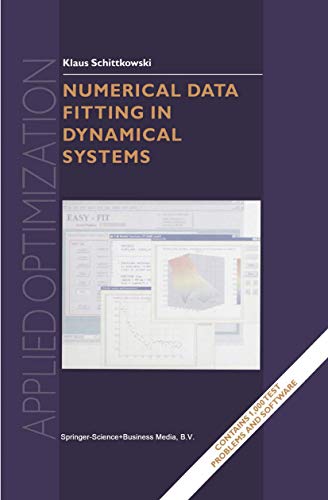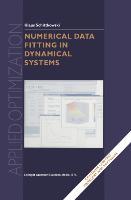Numerical Data Fitting Dynamical by Schittkowski Klaus (12 results)
Search filters
Product Type
- All Product Types
- Books (12)
- Magazines & Periodicals (No further results match this refinement)
- Comics (No further results match this refinement)
- Sheet Music (No further results match this refinement)
- Art, Prints & Posters (No further results match this refinement)
- Photographs (No further results match this refinement)
- Maps (No further results match this refinement)
- Manuscripts & Paper Collectibles (No further results match this refinement)
Condition Learn more
- New (12)
- As New, Fine or Near Fine (No further results match this refinement)
- Very Good or Good (No further results match this refinement)
- Fair or Poor (No further results match this refinement)
- As Described (No further results match this refinement)
Binding
Collectible Attributes
- First Edition (No further results match this refinement)
- Signed (No further results match this refinement)
- Dust Jacket (No further results match this refinement)
- Seller-Supplied Images (8)
- Not Print on Demand (7)
Language (1)
Price
- Any Price
- Under US$ 25 (No further results match this refinement)
- US$ 25 to US$ 50 (No further results match this refinement)
- Over US$ 50
Free Shipping
Seller Location
Seller Rating
-
Numerical Data Fitting in Dynamical Systems (Paperback)
Published by Springer-Verlag New York Inc., New York, NY, 2013
ISBN 10: 1475760507 ISBN 13: 9781475760507
Language: English
Seller: Grand Eagle Retail, Bensenville, IL, U.S.A.
Paperback. Condition: new. Paperback. Real life phenomena in engineering, natural, or medical sciences are often described by a mathematical model with the goal to analyze numerically the behaviour of the system. Advantages of mathematical models are their cheap availability, the possibility of studying extreme situations that cannot be handled by experiments, or of simulating real systems during the design phase before constructing a first prototype. Moreover, they serve to verify decisions, to avoid expensive and time consuming experimental tests, to analyze, understand, and explain the behaviour of systems, or to optimize design and production. As soon as a mathematical model contains differential dependencies from an additional parameter, typically the time, we call it a dynamical model. There are two key questions always arising in a practical environment: 1 Is the mathematical model correct? 2 How can I quantify model parameters that cannot be measured directly? In principle, both questions are easily answered as soon as some experimental data are available. The idea is to compare measured data with predicted model function values and to minimize the differences over the whole parameter space. We have to reject a model if we are unable to find a reasonably accurate fit. To summarize, parameter estimation or data fitting, respectively, is extremely important in all practical situations, where a mathematical model and corresponding experimental data are available to describe the behaviour of a dynamical system. Real life phenomena in engineering, natural, or medical sciences are often described by a mathematical model with the goal to analyze numerically the behaviour of the system. Shipping may be from multiple locations in the US or from the UK, depending on stock availability.
-
Numerical Data Fitting in Dynamical Systems: A Practical Introduction with Applications and Software (Applied Optimization)
Seller: Ria Christie Collections, Uxbridge, United Kingdom
US$ 349.84
Convert currencyUS$ 16.01 shipping from United Kingdom to U.S.A.Quantity: Over 20 available
Add to basketCondition: New. In.
-
Numerical Data Fitting in Dynamical Systems
Published by Springer US, Springer US Dez 2002, 2002
ISBN 10: 1402010796 ISBN 13: 9781402010798
Language: English
Seller: buchversandmimpf2000, Emtmannsberg, BAYE, Germany
US$ 383.52
Convert currencyUS$ 69.60 shipping from Germany to U.S.A.Quantity: 2 available
Add to basketBuch. Condition: Neu. Neuware -Real life phenomena in engineering, natural, or medical sciences are often described by a mathematical model with the goal to analyze numerically the behaviour of the system. Advantages of mathematical models are their cheap availability, the possibility of studying extreme situations that cannot be handled by experiments, or of simulating real systems during the design phase before constructing a first prototype. Moreover, they serve to verify decisions, to avoid expensive and time consuming experimental tests, to analyze, understand, and explain the behaviour of systems, or to optimize design and production. As soon as a mathematical model contains differential dependencies from an additional parameter, typically the time, we call it a dynamical model. There are two key questions always arising in a practical environment: 1 Is the mathematical model correct 2 How can I quantify model parameters that cannot be measured directly In principle, both questions are easily answered as soon as some experimental data are available. The idea is to compare measured data with predicted model function values and to minimize the differences over the whole parameter space. We have to reject a model if we are unable to find a reasonably accurate fit. To summarize, parameter estimation or data fitting, respectively, is extremely important in all practical situations, where a mathematical model and corresponding experimental data are available to describe the behaviour of a dynamical system. 412 pp. Englisch.
-
Numerical Data Fitting in Dynamical Systems : A Practical Introduction with Applications and Software
Seller: AHA-BUCH GmbH, Einbeck, Germany
US$ 388.13
Convert currencyUS$ 73.21 shipping from Germany to U.S.A.Quantity: 1 available
Add to basketTaschenbuch. Condition: Neu. Druck auf Anfrage Neuware - Printed after ordering - Real life phenomena in engineering, natural, or medical sciences are often described by a mathematical model with the goal to analyze numerically the behaviour of the system. Advantages of mathematical models are their cheap availability, the possibility of studying extreme situations that cannot be handled by experiments, or of simulating real systems during the design phase before constructing a first prototype. Moreover, they serve to verify decisions, to avoid expensive and time consuming experimental tests, to analyze, understand, and explain the behaviour of systems, or to optimize design and production. As soon as a mathematical model contains differential dependencies from an additional parameter, typically the time, we call it a dynamical model. There are two key questions always arising in a practical environment: 1 Is the mathematical model correct 2 How can I quantify model parameters that cannot be measured directly In principle, both questions are easily answered as soon as some experimental data are available. The idea is to compare measured data with predicted model function values and to minimize the differences over the whole parameter space. We have to reject a model if we are unable to find a reasonably accurate fit. To summarize, parameter estimation or data fitting, respectively, is extremely important in all practical situations, where a mathematical model and corresponding experimental data are available to describe the behaviour of a dynamical system.
-
Numerical Data Fitting in Dynamical Systems : A Practical Introduction with Applications and Software
Published by Springer US, Springer US, 2002
ISBN 10: 1402010796 ISBN 13: 9781402010798
Language: English
Seller: AHA-BUCH GmbH, Einbeck, Germany
US$ 396.52
Convert currencyUS$ 74.14 shipping from Germany to U.S.A.Quantity: 1 available
Add to basketBuch. Condition: Neu. Druck auf Anfrage Neuware - Printed after ordering - Real life phenomena in engineering, natural, or medical sciences are often described by a mathematical model with the goal to analyze numerically the behaviour of the system. Advantages of mathematical models are their cheap availability, the possibility of studying extreme situations that cannot be handled by experiments, or of simulating real systems during the design phase before constructing a first prototype. Moreover, they serve to verify decisions, to avoid expensive and time consuming experimental tests, to analyze, understand, and explain the behaviour of systems, or to optimize design and production. As soon as a mathematical model contains differential dependencies from an additional parameter, typically the time, we call it a dynamical model. There are two key questions always arising in a practical environment: 1 Is the mathematical model correct 2 How can I quantify model parameters that cannot be measured directly In principle, both questions are easily answered as soon as some experimental data are available. The idea is to compare measured data with predicted model function values and to minimize the differences over the whole parameter space. We have to reject a model if we are unable to find a reasonably accurate fit. To summarize, parameter estimation or data fitting, respectively, is extremely important in all practical situations, where a mathematical model and corresponding experimental data are available to describe the behaviour of a dynamical system.
-
Numerical Data Fitting in Dynamical Systems: A Practical Introduction with Applications and Software (Applied Optimization)
Seller: Revaluation Books, Exeter, United Kingdom
US$ 521.53
Convert currencyUS$ 16.71 shipping from United Kingdom to U.S.A.Quantity: 2 available
Add to basketPaperback. Condition: Brand New. 408 pages. 9.25x6.10x0.93 inches. In Stock.
-
Numerical Data Fitting in Dynamical Systems (Paperback)
Published by Springer-Verlag New York Inc., New York, NY, 2013
ISBN 10: 1475760507 ISBN 13: 9781475760507
Language: English
Seller: AussieBookSeller, Truganina, VIC, Australia
US$ 605.72
Convert currencyUS$ 37.00 shipping from Australia to U.S.A.Quantity: 1 available
Add to basketPaperback. Condition: new. Paperback. Real life phenomena in engineering, natural, or medical sciences are often described by a mathematical model with the goal to analyze numerically the behaviour of the system. Advantages of mathematical models are their cheap availability, the possibility of studying extreme situations that cannot be handled by experiments, or of simulating real systems during the design phase before constructing a first prototype. Moreover, they serve to verify decisions, to avoid expensive and time consuming experimental tests, to analyze, understand, and explain the behaviour of systems, or to optimize design and production. As soon as a mathematical model contains differential dependencies from an additional parameter, typically the time, we call it a dynamical model. There are two key questions always arising in a practical environment: 1 Is the mathematical model correct? 2 How can I quantify model parameters that cannot be measured directly? In principle, both questions are easily answered as soon as some experimental data are available. The idea is to compare measured data with predicted model function values and to minimize the differences over the whole parameter space. We have to reject a model if we are unable to find a reasonably accurate fit. To summarize, parameter estimation or data fitting, respectively, is extremely important in all practical situations, where a mathematical model and corresponding experimental data are available to describe the behaviour of a dynamical system. Real life phenomena in engineering, natural, or medical sciences are often described by a mathematical model with the goal to analyze numerically the behaviour of the system. Shipping may be from our Sydney, NSW warehouse or from our UK or US warehouse, depending on stock availability.
-
Numerical Data Fitting in Dynamical Systems
Published by Springer US Apr 2013, 2013
ISBN 10: 1475760507 ISBN 13: 9781475760507
Language: English
Seller: BuchWeltWeit Ludwig Meier e.K., Bergisch Gladbach, Germany
US$ 318.33
Convert currencyUS$ 26.68 shipping from Germany to U.S.A.Quantity: 2 available
Add to basketTaschenbuch. Condition: Neu. This item is printed on demand - it takes 3-4 days longer - Neuware -Real life phenomena in engineering, natural, or medical sciences are often described by a mathematical model with the goal to analyze numerically the behaviour of the system. Advantages of mathematical models are their cheap availability, the possibility of studying extreme situations that cannot be handled by experiments, or of simulating real systems during the design phase before constructing a first prototype. Moreover, they serve to verify decisions, to avoid expensive and time consuming experimental tests, to analyze, understand, and explain the behaviour of systems, or to optimize design and production. As soon as a mathematical model contains differential dependencies from an additional parameter, typically the time, we call it a dynamical model. There are two key questions always arising in a practical environment: 1 Is the mathematical model correct 2 How can I quantify model parameters that cannot be measured directly In principle, both questions are easily answered as soon as some experimental data are available. The idea is to compare measured data with predicted model function values and to minimize the differences over the whole parameter space. We have to reject a model if we are unable to find a reasonably accurate fit. To summarize, parameter estimation or data fitting, respectively, is extremely important in all practical situations, where a mathematical model and corresponding experimental data are available to describe the behaviour of a dynamical system. 412 pp. Englisch.
-
Numerical Data Fitting in Dynamical Systems
Seller: moluna, Greven, Germany
US$ 320.05
Convert currencyUS$ 56.83 shipping from Germany to U.S.A.Quantity: Over 20 available
Add to basketCondition: New. Dieser Artikel ist ein Print on Demand Artikel und wird nach Ihrer Bestellung fuer Sie gedruckt. Real life phenomena in engineering, natural, or medical sciences are often described by a mathematical model with the goal to analyze numerically the behaviour of the system. Advantages of mathematical models are their cheap availability, the possibility of.
-
Numerical Data Fitting in Dynamical Systems
Seller: moluna, Greven, Germany
US$ 320.05
Convert currencyUS$ 56.83 shipping from Germany to U.S.A.Quantity: Over 20 available
Add to basketGebunden. Condition: New. Dieser Artikel ist ein Print on Demand Artikel und wird nach Ihrer Bestellung fuer Sie gedruckt. Real life phenomena in engineering, natural, or medical sciences are often described by a mathematical model with the goal to analyze numerically the behaviour of the system. Advantages of mathematical models are their cheap availability, the possibility of.
-
Numerical Data Fitting in Dynamical Systems
Published by Springer US Dez 2002, 2002
ISBN 10: 1402010796 ISBN 13: 9781402010798
Language: English
Seller: BuchWeltWeit Ludwig Meier e.K., Bergisch Gladbach, Germany
US$ 383.52
Convert currencyUS$ 26.68 shipping from Germany to U.S.A.Quantity: 2 available
Add to basketBuch. Condition: Neu. This item is printed on demand - it takes 3-4 days longer - Neuware -Real life phenomena in engineering, natural, or medical sciences are often described by a mathematical model with the goal to analyze numerically the behaviour of the system. Advantages of mathematical models are their cheap availability, the possibility of studying extreme situations that cannot be handled by experiments, or of simulating real systems during the design phase before constructing a first prototype. Moreover, they serve to verify decisions, to avoid expensive and time consuming experimental tests, to analyze, understand, and explain the behaviour of systems, or to optimize design and production. As soon as a mathematical model contains differential dependencies from an additional parameter, typically the time, we call it a dynamical model. There are two key questions always arising in a practical environment: 1 Is the mathematical model correct 2 How can I quantify model parameters that cannot be measured directly In principle, both questions are easily answered as soon as some experimental data are available. The idea is to compare measured data with predicted model function values and to minimize the differences over the whole parameter space. We have to reject a model if we are unable to find a reasonably accurate fit. To summarize, parameter estimation or data fitting, respectively, is extremely important in all practical situations, where a mathematical model and corresponding experimental data are available to describe the behaviour of a dynamical system. 412 pp. Englisch.
-
Numerical Data Fitting in Dynamical Systems
Published by Springer US, Springer New York Apr 2013, 2013
ISBN 10: 1475760507 ISBN 13: 9781475760507
Language: English
Seller: buchversandmimpf2000, Emtmannsberg, BAYE, Germany
US$ 383.52
Convert currencyUS$ 69.60 shipping from Germany to U.S.A.Quantity: 1 available
Add to basketTaschenbuch. Condition: Neu. This item is printed on demand - Print on Demand Titel. Neuware -Real life phenomena in engineering, natural, or medical sciences are often described by a mathematical model with the goal to analyze numerically the behaviour of the system. Advantages of mathematical models are their cheap availability, the possibility of studying extreme situations that cannot be handled by experiments, or of simulating real systems during the design phase before constructing a first prototype. Moreover, they serve to verify decisions, to avoid expensive and time consuming experimental tests, to analyze, understand, and explain the behaviour of systems, or to optimize design and production. As soon as a mathematical model contains differential dependencies from an additional parameter, typically the time, we call it a dynamical model. There are two key questions always arising in a practical environment: 1 Is the mathematical model correct 2 How can I quantify model parameters that cannot be measured directly In principle, both questions are easily answered as soon as some experimental data are available. The idea is to compare measured data with predicted model function values and to minimize the differences over the whole parameter space. We have to reject a model if we are unable to find a reasonably accurate fit. To summarize, parameter estimation or data fitting, respectively, is extremely important in all practical situations, where a mathematical model and corresponding experimental data are available to describe the behaviour of a dynamical system.Springer Verlag GmbH, Tiergartenstr. 17, 69121 Heidelberg 412 pp. Englisch.










